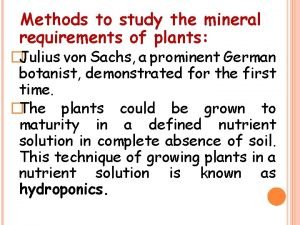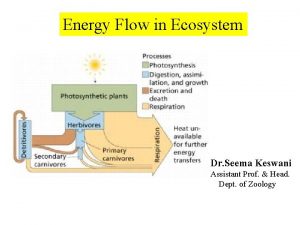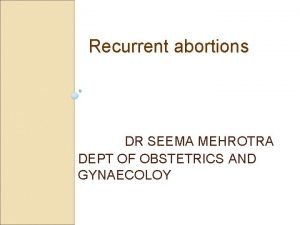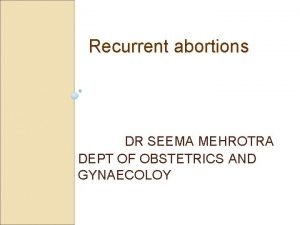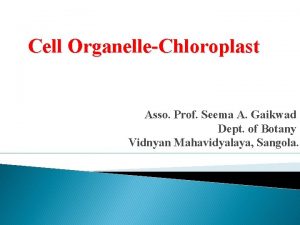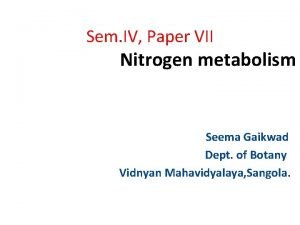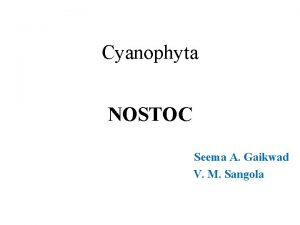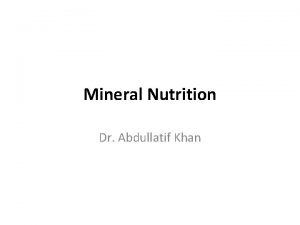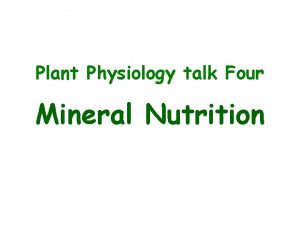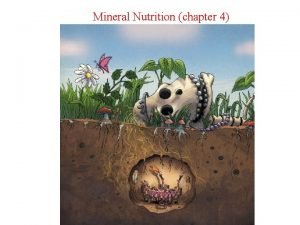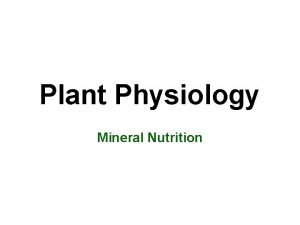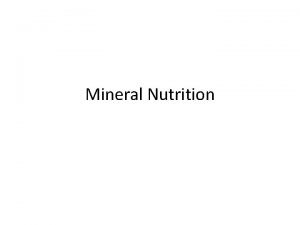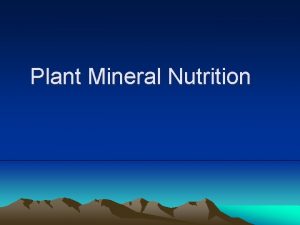MINERAL NUTRITION Asso Prof Seema A Gaikwad Dept













- Slides: 13

MINERAL NUTRITION Asso. Prof. Seema A. Gaikwad Dept. of Botany Vidnyan Mahavidyalaya, Sangola.

Defination The supply of inorganic substances from the soil to the plants for growth and development is known as ‘Mineral Nutrition’

Introduction The elements that are required or necessary for plants to complete their life cycle are called essential plant nutrients. Each has a critical function in plants and are required in varying amounts in plant tissue. Most of the elements are available as minerals in the soil. Presently, 17 mineral elements are considered essential for plant growth. Each is equally important to the plant, yet each is required in vastly different amounts. These differences have led to the grouping of these essential elements into three categories; primary (macro) nutrients, secondary nutrients, and micronutrients.

The primary macronutrients: nitrogen (N), phosphorus (P), potassium (K). The secondary macronutrients: calcium (Ca), magnesium (Mg) The micronutrients/trace minerals: manganese (Mn), iron(Fe), copper (Cu), The macronutrients required in relatively large amounts, usually >> 1 mg/g dry wt of tissue. The micronutrients required in relatively small amounts, < 0. 1 mg/g dry wt of tissue.

Role and Deficiency Symptoms Nitrogen (N) Role- Necessary formation of amino acids, the building blocks of protein. Essential for plant cell division, vital for plant growth. Directly involved in photosynthesis. Necessary component of vitamins. Aids in production and use of carbohydrates. Affects energy reactions in the plant Deficiency Symptoms-Plants which have Nitrogen for only limited growth, may exhibit chlorosis especially in the older leaves. In severe cases, the leaves first yellow and then tan as they die. Some plants (tomatoes, maize) may exhibit a purplish colouration of the stems, petioles and on the underside of their leaves.

Phophorous (P) Role- Involved in photosynthesis, respiration, energy storage and transfer, cell division, and enlargement, Promotes early root formation and growth, Improves quality of fruits, vegetables, and grains, Vital to seed formation. Deficiency Symptoms Plants exhibit stunted growth and leaves are often dark green in colour. Oldest leaves become dark brown as they die. Maturity may be delayed.

Potassium Role- Carbohydrate metabolism and the (K) break down and translocation of starches, Increases photosynthesis, Increases water-use efficiency, Essential to protein synthesis, Important in fruit formation, Activates enzymes and controls their reaction rates, Improves quality of seeds and fruit Increases disease resistance. Deficiency Symptoms- Crops suffering this deficiency appear scorched around the edges and surfaces are irregularly chlorotic. In legumes, the chlorotic spots form patterns around the leaf edges. Cereal grains develop weak stalks and their roots may become more prone to infection by root rotting organisms

Magnesium (Mg) Role- Key element of chlorophyll production, Improves utilization and mobility of phosphorus, Activator and component of many plant enzymes, Increases iron utilization in plants , Influences earliness and uniformity of maturity. Deficiency Symptoms - Interveinal chlorosis of older leaves, mortality, In severe deficiency the leaves wilt & shed, leaves develop necrotic patches.

Calcium (Ca) Role- Utilized for Continuous cell division and formation, Involved in nitrogen metabolism , Reduces plant respiration, Aids translocation of photosynthesis from leaves to fruiting organs, Increases fruit set , Stimulates microbial activity. Deficiency Symptoms A notable feature of calcium-deficient plants is a defective root system. Calcium deficiency causes stunting of root systems , effect on the visual appearance of leaves.

Iron (Fe) Role- Promotes formation of chlorophyll , Acts as an oxygen carrier , Reactions involving cell division and growth Deficiency Symptoms Young leaves develop chlorosis in the interveinal areas which may develop into white leaves with necrotic spots. Stunted growth. In animals, iron deficiency results in anaemia, wasting and eventual death.

Copper (Cu) Role- Catalyzes several plant processes, Major function in photosynthesis, Major function in reproductive stages, Indirect role in chlorophyll production, Increases sugar content, Improves flavor of fruits and vegetables. Deficiency Symptoms Young leaves become dark green, twisted and deformed, Necrotic spots may appear. In grains and grasses, seed production is reduced and seed heads may be white and empty.

Manganese (Mn) Role- Functions as a part of certain enzyme systems, It is an essential nutrient for the growth of both plants and animals. In plants it enhances root growth, disease resistance and the development of fruit. It is required for the synthesis of chlorophyll and assimilation of nitrate. It is involved in the activation of many enzymes involved in photosynthesis and respiration. Deficiency Symptoms-Wilting of leaves, followed by premature leaf fall, Appearance of ‘greenish gray’, oval shaped spots on basal regions of young leaves, Poorly developed root system, Necrosis in older leaves, In cereals, grain formation is affected and number is reduced.

Thank You

